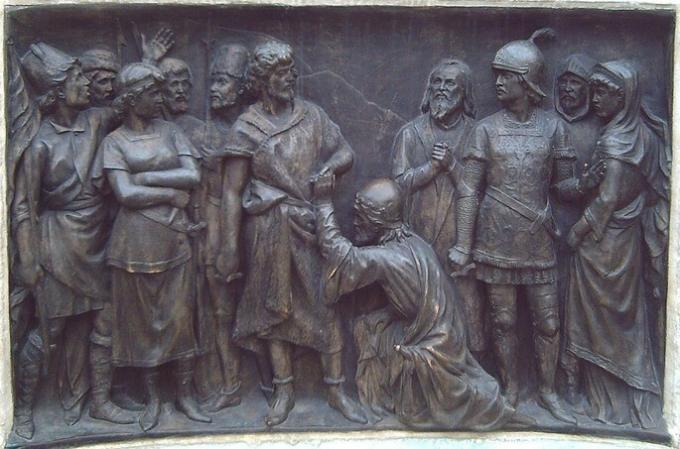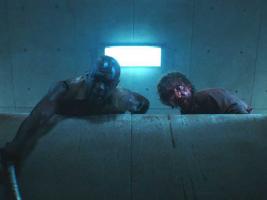Life is a dream: analysis and summary of the work and the monologues (poems)
The life is dream, by Pedro Calderón de la Barca (1600-1681), is a play written in 1635, whose protagonist, Prince Sigismund, wonders about the meaning of life while he is in captivity.
It is a baroque work characterized by philosophical ideas about life, the use of scenery to contrast antagonistic ideas and the importance of civilization over barbarism.
The drama revolves around the deprivation of freedom of Sigismund by his father, King Basil of Poland, who he locks up for fear that the predictions of a consulted oracle will be fulfilled, according to which it would defeat and humiliate him.
The life is dream, by Pedro Calderón de la Barca, is written in verse divided into three days or acts. The two main plots are, on the one hand, the confinement of Sigismund and, on the other hand, the engagement between Rosaura and Astolfo (the king's nephew who would inherit the throne).
First working day: Rosaura, accompanied by Clarín, arrives in Poland disguised as a man to demonstrate her noble origin, since Prince Astolfo has despised her for being her illegitimate daughter. Rosaura finds the prisoner Sigismund, but he tries to kill her. Clotaldo, Sigismund's tutor, protects her from her.
At court, King Basilio confesses to his nephews Estrella and Astolfo that the prisoner is his son, whom he locked away for fear of the prophecy according to which he was going to defeat and humiliate him in front of the people. To ease his conscience, the king frees Sigismund for a day. If there were signs of alarm, Sigismund would be locked up again, and Estrella and Astolfo would be the heirs to the throne.
Second dayBefore releasing him, Sigismund is drugged, who awakens in a hall in the palace as the prince. Meanwhile, Rosaura discovers that Clotaldo is her father and that Astolfo has a double game. In this confusion, Sigismund behaves like a tyrant. He tries to abuse Rosaura and throws a servant out the window. The king locks up Sigismund again as planned. To do this, they drug him again and persuade him that it was all a dream. There he pronounces the monologue And dreams, dreams are.
Third day: The town finds out of the existence of Sigismund, legitimate heir, and a revolt is organized to free it. The king's troops face those of Sigismund, who wins the battle. Clarín dies in the confrontation. With the king humiliated, part of the prophecy is fulfilled, but Sigismund prostrates himself at the feet of his father, recognizing his authority. Faced with the humility of his son, Basilio voluntarily inherits the throne from Sigismund. The new king marries Estrella, and Astolfo with Rosaura.
Analysis of The life is dream
The life is dream, by Pedro Calderón de la Barca, deals with the opposition and duality between free will and predestination as well as between reality and dreams.
Interest in these topics is justified, since The life is dream it was written in full baroque context. At this time, the conception of the universe changed radically from geocentrism (the earth as the center), to heliocentrism (the sun as the center), which was a new paradigm and, clearly, a shock spiritual.
In addition, Pedro Calderón de la Barca writes The life is dream in a time where the issue of civilization versus barbarism is present, as a consequence of the discovery of America and the development of colonization.
Oh misero de me!: free will and predestination
This new conception of the world was conjugated at the same time with the religious struggle between the Lutheran Reformation and the Catholic Counter-Reformation. The Lutheran position was in favor of predestination, while the Catholic position was in defense of free will.
Sigismund expresses the conflict between his free will and predestination in his first monologue. The first monologue, known as "Oh mísero de me !!!" It is the entrance of Sigismund on the first day of the work where he exposes the misery of the deprivation of her freedom to the lady Rosaura when she is she discovers him chained and dressed in skins. The main theme revolves around what is free will and its relationship with predestination.
Monologue (poem) of Sigismund "Oh miser of me!" from The life is dream
Oh miserable me! And alas unhappy!
Hurry up, dear, I pretend
since you treat me like that,
what crime did I commit against you when I was born;
although if I was born, I already understand
what crime I have committed.
Enough cause has had
your justice and rigor;
Well, the felony
of man is to have been born.I just want to know
to speed up my sleepless nights
(leaving a part, heavens,
the crime of being born),
what else could I offend you,
to punish me more.
Weren't the others born?
Well if the others were born,
What privileges did they have
that I never enjoyed?The bird is born, and with the finery
that give it great beauty,
it is hardly a feather flower,
or corsage with wings
when the ethereal halls
cut with speed,
refusing mercy
of the nest that leaves calm:
And having more soul,
do I have less freedom?The brute is born, and with the skin
that draw beautiful spots,
hardly a sign is made of stars,
thanks to the learned brush,
when, daring and cruel,
the human need
teaches him to be cruel,
Labyrinth monster from him:
And me with better different
do I have less freedom?The fish is born, it does not breathe,
abortion of eggs and lamas,
and barely a vessel of scales
on the waves you look,
when it turns everywhere,
measuring the vastness
of so much capacity
as it gives the cold center:
What about me with more free will
do I have less freedom?The stream is born, snake
that is unleashed among flowers,
and scarcely, silver serpent,
among the flowers it breaks,
when musician celebrates
of the flowers pity
that give you the majesty
the open field on his way:
And having more life
do I have less freedom?In reaching this passion
a volcano, an Etna made,
I would like to get off the chest
pieces of the heart.
What law, justice or reason
deny men know
such a privilege,
such a main exception,
that God has given to a crystal,
a fish, a brute and a bird?
Life is a dream or And dreams, dreams are: reality and dream
The theme of the duality between reality and dream in The life is dream by Pedro Calderón de la Barca is reflected in the use of light and shadow, characteristic of the Baroque period, on stage.
Sigismund wonders what reality is compared to dreams, since he never knew a life outside of the dream when he found himself locked up since he was born. When Sigismund is unknowingly granted a day in reality, this seems more like a dream, making the protagonist question life in his famous second monologue.
Known as "Life is a dream" or also for his most famous verse "And dreams are dreams", the second monologue serves as the closing of the second day of the play. The main theme of the soliloquy that gives the work its name delves into what life is and how reality differs from a dream.
Monologue (poem) of Sigismund "Life is a dream" or "And dreams are dreams"
It's true; well we repress
this fierce condition,
this fury, this ambition
In case we ever dream
And yes we will, well we are
in such a singular world,
that living is only dreaming;
and experience teaches me
that the man who lives dreams
what it is up to waking up.The king dreams that he is king, and he lives
with this deception commanding,
arranging and governing;
and this applause that he receives
borrowed, in the wind he writes,
and turns him to ashes
death (strong misery!);
That there are those who try to reign,
seeing that he has to wake up
in the dream of death!The rich man dreams of his wealth
What more care offers you;
dreams the poor man who suffers
his misery and his poverty;
the one who begins to thrive dreams,
the one who toils and pretends dreams,
he who grieves and offends dreams;
and in the world, in conclusion,
everyone dreams what they are,
although no one understands it.I dream i'm here
these prisons loaded,
and I dreamed that in another state
more flattering I saw myself.
What is life? A frenzy.
What is life? An illusion,
a shadow, a fiction,
and the greatest good is small;
that all life is a dream,
and dreams are dreams.
Characters of The life is dream

The life is dream, by Pedro Calderón de la Barca, is made up of seven characters who have dialogues:
Sigismund
He is he protagonist of the work, prince and son of King Basil of Poland. His transformation throughout the play ranges from satisfying his desire for revenge at the beginning to manifesting his more human character in him at the end.
King Basil of Poland
He is the father of Sigismund. He locks up his son out of fear of the prophecy in which he is defeated and humiliated by it.
Rosaura
She is the lady who discovers Sigismund in his dungeon. She is engaged to Astolfo, the king's nephew, but she discovers his infidelities. He later learns that she is the daughter of Clotaldo, Sigismund's lackey.
Clarion
He is a secondary character within the play. He is Rosaura's squire and attends to the comic prototype within the play.
Clotaldo
He is Sigismund's lackey and Rosaura's true father. To him all the knowledge of Sigismund is owed, since he has been in charge of teaching it.
Astolfo
He is a prince and nephew of King Basilio. He is the one chosen by the king to inherit the throne. He is engaged to Rosaura but breaks her engagement to marry the Infanta Estrella.
Infanta Star
She is the future wife of Sigismund, that is, future queen of Poland. However, before becoming the protagonist's wife, she becomes engaged to Astolfo.
Pedro Calderon de la Barca

Pedro Calderon de la Barca he was a Spanish writer of the Baroque era. He was born into a noble family in 1600 in Madrid, where during his youth he began his studies at a Jesuit college.
Later, during his university stage, he studied Canons and Law at the Universities of Alcalá and, later, that of Salamanca. Later, he oriented his life to military service.
Also, he later becomes the playwright at the court of Philip IV. Then, around the year 1623, one of his first comedies came to light. However, it is not until the year 1642 that he becomes involved in the literary world, once he retires from military service.
Pedro Calderón de la Barca died in Madrid in 1681. Among his most important works are:
- The life is dream (1635)
- The goblin lady (1636)
- The constant prince (1636)
- The magic prodigy (1637)
- The physician of his honor (1637)
- The mayor of Zalamea (1651)
- The great theater of the world (1655)
You may also like: Baroque: characteristics, representatives and works.



